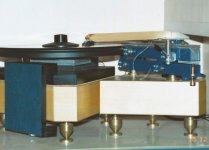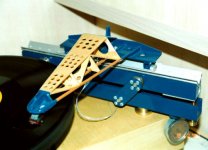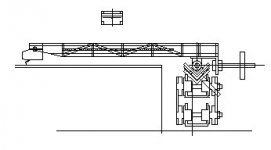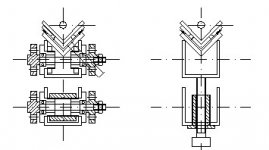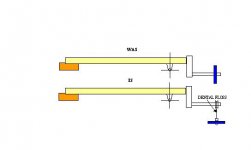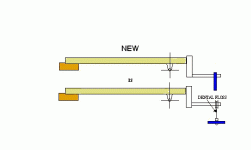Hi guys!
Being an engineer mysef, I never thought such a piece of precise engineering like tonearm may be succesfully build "on the kitchen table". Yet the brilliant design of Poul Ladegaard has really changed my mind. I hope my experience of building air bearing tangential tonearm may be useful for someone want to improve his analog front end without spending alot of funds.
Original Ladegaard design is well described by Roscoe Primrose in his site. My modification points mainly are:
1. VTA on-flight adjustment mechanism: Dennesen-style linkage, using small ball bearings, aluminium profiles filled with lead casting into it and then glued with epoxy. This is the most time/money consuming part, but not a must for the less sensitive to VTA cartriges, like Shure V15.
2. Light wooden arm. The reasons are: 1)low pressure air bearing is not perfectly stiff and therefore should not be loaded by the high arm mass, and 2) light arm can handle non-concentric LP better. There are two versions: 3mm pine beams/1.5 mm plywood framework and pine/balsa wood, even lighter. Aquarium pump drives them easily. There was no significant sonical difference between them, but the lighter arm can really dance on very non-concentric vinyl (3-4 mm) with no audible effect. The light arm dictates high compliance cartrige: Shure V15 was the obvious choise.
3. Wide base vertical bearing (took from the old cardan tonearm). Wider base makes the whole bearing stiffer.
4. Separate 3-points adjustable base for the arm and platter. Precise overhang and 3-D angle adjustment is essential, both for the tonearm and platter.
Overall, I'm happy with this arm: Shure V15 does really sing without annoying arm resonances, driving me mad with the Project 6.9 (pretty audible through headphones). I can live with this set up even using mediocre electronic - integrated NAD 304 and enjoy my beloved classic records (much more demanding than jazz and rock). Currently I use the Project 6.9 platter - homebrewed platter will be the next step. Planning to get EAR phono stage - I feel this arm will do its best with the appropriate platter and amplifying.
Comments, questions are wellcomed.
Being an engineer mysef, I never thought such a piece of precise engineering like tonearm may be succesfully build "on the kitchen table". Yet the brilliant design of Poul Ladegaard has really changed my mind. I hope my experience of building air bearing tangential tonearm may be useful for someone want to improve his analog front end without spending alot of funds.
Original Ladegaard design is well described by Roscoe Primrose in his site. My modification points mainly are:
1. VTA on-flight adjustment mechanism: Dennesen-style linkage, using small ball bearings, aluminium profiles filled with lead casting into it and then glued with epoxy. This is the most time/money consuming part, but not a must for the less sensitive to VTA cartriges, like Shure V15.
2. Light wooden arm. The reasons are: 1)low pressure air bearing is not perfectly stiff and therefore should not be loaded by the high arm mass, and 2) light arm can handle non-concentric LP better. There are two versions: 3mm pine beams/1.5 mm plywood framework and pine/balsa wood, even lighter. Aquarium pump drives them easily. There was no significant sonical difference between them, but the lighter arm can really dance on very non-concentric vinyl (3-4 mm) with no audible effect. The light arm dictates high compliance cartrige: Shure V15 was the obvious choise.
3. Wide base vertical bearing (took from the old cardan tonearm). Wider base makes the whole bearing stiffer.
4. Separate 3-points adjustable base for the arm and platter. Precise overhang and 3-D angle adjustment is essential, both for the tonearm and platter.
Overall, I'm happy with this arm: Shure V15 does really sing without annoying arm resonances, driving me mad with the Project 6.9 (pretty audible through headphones). I can live with this set up even using mediocre electronic - integrated NAD 304 and enjoy my beloved classic records (much more demanding than jazz and rock). Currently I use the Project 6.9 platter - homebrewed platter will be the next step. Planning to get EAR phono stage - I feel this arm will do its best with the appropriate platter and amplifying.
Comments, questions are wellcomed.
Attachments
Very impressed
I keep hearing good things about this arm, but I looked at it and thought, nah, something like that really can't work well can it? I'm finally convinced to give it a go., when the current round of projects are finished next year. I just bought another SAEC, so that makes, 3TTs and 6 arms.
I really love that bridge armtube, and have wanted to try something similar, ever since I saw <a href="http://www.audioadvancements.com/tonearms/goldengate.gif">this.</a>
Can't wait to hear non-audiophile reactions to it: turntables, tubes, horns, and a very Rube Goldberg looking tonearm.
Your pix have been saved on my HDD for future reference.
I keep hearing good things about this arm, but I looked at it and thought, nah, something like that really can't work well can it? I'm finally convinced to give it a go., when the current round of projects are finished next year. I just bought another SAEC, so that makes, 3TTs and 6 arms.
I really love that bridge armtube, and have wanted to try something similar, ever since I saw <a href="http://www.audioadvancements.com/tonearms/goldengate.gif">this.</a>
Can't wait to hear non-audiophile reactions to it: turntables, tubes, horns, and a very Rube Goldberg looking tonearm.
Your pix have been saved on my HDD for future reference.
Ladegaard Tonearm: Best Project In DIY Audio.
(Is everyone as bored of hearing me say it as I am of saying it?)

Nice job, livemusic, looks like a cool implementation. I like your VTA setup very much, I had been thinking along those lines myself. Note that coarse VTA can be set with stacks of shims (even coins) under the air bearing if need be, but your way is much nicer.
-j
(Is everyone as bored of hearing me say it as I am of saying it?)
Nice job, livemusic, looks like a cool implementation. I like your VTA setup very much, I had been thinking along those lines myself. Note that coarse VTA can be set with stacks of shims (even coins) under the air bearing if need be, but your way is much nicer.
-j
Where can I get out?! 
Nice! Thats the best looking DIY tonearm I've ever seen. What is it made of and how did you build it? As you can read from my other post I'm building my own turntable using the Teres motor and bearing. Wonder what it would take to make this tonearm
*Analog fans may be blind
but digital fans are deaf*
Nice! Thats the best looking DIY tonearm I've ever seen. What is it made of and how did you build it? As you can read from my other post I'm building my own turntable using the Teres motor and bearing. Wonder what it would take to make this tonearm
*Analog fans may be blind
but digital fans are deaf*
Re: StylinLP
Materials used: 3X3 mm red pine beams and 1.5 mm aviation plywood (1 mm also seems enough) for the first arm and the same beams + 1mm balsa wood veneer for the second one. Parts are glued together with yellow carpenter glue. 5-6 layers of polyurethane laquer are applyed in the end. The main design goal is high torsion stiffness at minimum weight. For the balsa arm it is achieved by glueng the inner partitions (placed like framework) to the 2 mm brass tube, going through the arm in the middle of it and also used to lead the wires. BHW, balsa has good gamping properties. The headshell is simple plate of 1 mm brass, glued to the structure beams with epoxy. Anodised aluminium angles used for the lateral elements are bolted and glued together with epoxy. Brass counterweight CG is laying in the the same horizontal plane with the record and vertical pivot axle, and placed as close to the pivot as possible, to minimize vertical effective mass.
Hope this superficial description will help. If you are interested in CAD drawings, e-mail me. BTW, I also intent to use Teres bearing and motor for the further project development.
Cheers,
Michael
Materials used: 3X3 mm red pine beams and 1.5 mm aviation plywood (1 mm also seems enough) for the first arm and the same beams + 1mm balsa wood veneer for the second one. Parts are glued together with yellow carpenter glue. 5-6 layers of polyurethane laquer are applyed in the end. The main design goal is high torsion stiffness at minimum weight. For the balsa arm it is achieved by glueng the inner partitions (placed like framework) to the 2 mm brass tube, going through the arm in the middle of it and also used to lead the wires. BHW, balsa has good gamping properties. The headshell is simple plate of 1 mm brass, glued to the structure beams with epoxy. Anodised aluminium angles used for the lateral elements are bolted and glued together with epoxy. Brass counterweight CG is laying in the the same horizontal plane with the record and vertical pivot axle, and placed as close to the pivot as possible, to minimize vertical effective mass.
Hope this superficial description will help. If you are interested in CAD drawings, e-mail me. BTW, I also intent to use Teres bearing and motor for the further project development.
Cheers,
Michael
fantastic looking arm!
I have lingering plans to build a Ladegaard myself someday.
I was wondering though about the need for the armtube to be light, Jeremy Epstein uses (used?) a Denon DL103 with it so I guess his will be rather heavier than yours. What makes you think this is not a good idea?
I have lingering plans to build a Ladegaard myself someday.
I was wondering though about the need for the armtube to be light, Jeremy Epstein uses (used?) a Denon DL103 with it so I guess his will be rather heavier than yours. What makes you think this is not a good idea?
peterr said:fantastic looking arm!
I have lingering plans to build a Ladegaard myself someday.
I was wondering though about the need for the armtube to be light, Jeremy Epstein uses (used?) a Denon DL103 with it so I guess his will be rather heavier than yours. What makes you think this is not a good idea?
Mostly excentric records tracking problem. I noticed the volume level floating with my rather excentric test record, playing lateral modulations track. This was less audible with lighter arm. It seems to me also the lighter arm does match the Shure V15 better.
I intend to measure the actual effective mass for both arms. Would be interesting to learn if the natural resonance frequency is within recommended band.
Cheers
Michael
Clicking through the posts I found myself admiring your arm again 
A few more questions came up:
What kind of wire did you use?
Is the lower part of the airbearing just loosely resting on the VTA adjustment-screw or is it solidly fixed in some way?
Would it be possible to have some more pictures of the backside and the glider construction?
just curious.
A few more questions came up:
What kind of wire did you use?
Is the lower part of the airbearing just loosely resting on the VTA adjustment-screw or is it solidly fixed in some way?
Would it be possible to have some more pictures of the backside and the glider construction?
just curious.
Hi Peter,
Re your questions:
Wires are Van der Hul MSS7 - very flexible, good an inexpensive.
There are five of them - one is grounding the wire guide tube.
Upper rail is just resting on VTA screw, contacting through teflon strip. Filling it with lead casting makes it massive and pretty inert.
I have no digital camera, so I cannot make some more pictures now. Hope attached drawing fragments give you an idea how it is built. The pivot bearing is made of old Technics tonearm: I cut the outer frame such the triangle plate with small pressed ajustable cone was made of it, and glued on the glider. The mating bearing part is cut of the inner frame, in form of short "legs" and glued again to lateral beam.
Good luck!
Michael
Re your questions:
Wires are Van der Hul MSS7 - very flexible, good an inexpensive.
There are five of them - one is grounding the wire guide tube.
Upper rail is just resting on VTA screw, contacting through teflon strip. Filling it with lead casting makes it massive and pretty inert.
I have no digital camera, so I cannot make some more pictures now. Hope attached drawing fragments give you an idea how it is built. The pivot bearing is made of old Technics tonearm: I cut the outer frame such the triangle plate with small pressed ajustable cone was made of it, and glued on the glider. The mating bearing part is cut of the inner frame, in form of short "legs" and glued again to lateral beam.
Good luck!
Michael
Attachments
Decoupled counterweight
Conti, the famous Basis Vector tonearm designer claims all the linear trackers have an inherent drawback: the lateral effective mass is too high. May be, it makes sense, thinking about huge difference between its lateral and vertical effective mass; the cart has no such a divergence in vertical and horizontal compliance, it’s for sure. This is the reason why the linear tracker designers are trying to make the slider as light as possible, ecpecially for the highly comliant carts. So, I also started to figure out how to minimize tonearm lateral mass, couse my Shure V15R known by its high comliance.
Browsing through the Teres owners’ forum, I came across an interesting OL Silver tonearm modification by decoupling the counterweight from tonearm. Pretty simple idea: just hang the counterweight on the string under it's usual place on the tonearm tube. Though it was claimed, this increases the lateral effective mass, to my opinion, quite the reverse: it is getting lower. The tonearm effective mass is actually its moment of inertia around the pivot axle, in the other words, the inertial resistance of mass to externally applied force, causing the arm to rotate/move. So, if the lateral force is applied, the counterweight inertial reaction on the arm is close to zero, if hanged on the string, because the counterweight stays on place in the very first moment due to its inertia. The lateral dynamic effective mass may be about halved by this method; in my case the counterweight mass is roughly equal to the rest of the arm mass.
Anyway, I took the old arm lead counterweight, in form of short cylinder with the center hole, made a loop on the each side of dental floss piece (non-stretchable) and hanged it about 3.5 cm under its place on the arm.
Guys, It works!
The overall tonal balance just became right, slight distortions on the very hights are gone. Orchestral winds sound amazingly natural first time since I'm in vinyl. Each voice has now its own character and every bow touch is palpable. The arm deals with heavily eccentric records with ease.
Today, is sounds even better, after I made the weight in form of disc, in order to increase the pendulum length and thereby to lower the resonant frequency.
I'm very pleased with the improvement (at no-cost). Highly recommended!
Conti, the famous Basis Vector tonearm designer claims all the linear trackers have an inherent drawback: the lateral effective mass is too high. May be, it makes sense, thinking about huge difference between its lateral and vertical effective mass; the cart has no such a divergence in vertical and horizontal compliance, it’s for sure. This is the reason why the linear tracker designers are trying to make the slider as light as possible, ecpecially for the highly comliant carts. So, I also started to figure out how to minimize tonearm lateral mass, couse my Shure V15R known by its high comliance.
Browsing through the Teres owners’ forum, I came across an interesting OL Silver tonearm modification by decoupling the counterweight from tonearm. Pretty simple idea: just hang the counterweight on the string under it's usual place on the tonearm tube. Though it was claimed, this increases the lateral effective mass, to my opinion, quite the reverse: it is getting lower. The tonearm effective mass is actually its moment of inertia around the pivot axle, in the other words, the inertial resistance of mass to externally applied force, causing the arm to rotate/move. So, if the lateral force is applied, the counterweight inertial reaction on the arm is close to zero, if hanged on the string, because the counterweight stays on place in the very first moment due to its inertia. The lateral dynamic effective mass may be about halved by this method; in my case the counterweight mass is roughly equal to the rest of the arm mass.
Anyway, I took the old arm lead counterweight, in form of short cylinder with the center hole, made a loop on the each side of dental floss piece (non-stretchable) and hanged it about 3.5 cm under its place on the arm.
Guys, It works!
The overall tonal balance just became right, slight distortions on the very hights are gone. Orchestral winds sound amazingly natural first time since I'm in vinyl. Each voice has now its own character and every bow touch is palpable. The arm deals with heavily eccentric records with ease.
Today, is sounds even better, after I made the weight in form of disc, in order to increase the pendulum length and thereby to lower the resonant frequency.
I'm very pleased with the improvement (at no-cost). Highly recommended!
Attachments
Re: FOUCAULTS' PENDULUM.
Hi Frank,
To my surprise, the arm works well on the warped and and eccentric records, much better than before.
Anyway, I started to think how to damp the pendulum oscillations...
Cheers,
Michael
fdegrove said:Hi Michael,
Glad to see it improved your tonearm...
Still, I'd feel more comfortable if other ways were devised to achieve the same results.
It wil work fine as long as you're records are perfectly flat.
Hi Frank,
To my surprise, the arm works well on the warped and and eccentric records, much better than before.
Anyway, I started to think how to damp the pendulum oscillations...
Cheers,
Michael
LA PENDULE...
Hi,
Don't damp, prevent them...and it's easy Michael.
Hi,
Anyway, I started to think how to damp the pendulum oscillations...
Don't damp, prevent them...and it's easy Michael.
Re: LA PENDULE...
Let me guess... magnets?
fdegrove said:Hi,
Don't damp, prevent them...and it's easy Michael.
Let me guess... magnets?
- Status
- This old topic is closed. If you want to reopen this topic, contact a moderator using the "Report Post" button.
- Home
- Source & Line
- Analogue Source
- Ladegaard tonearm - the real DIY winner
